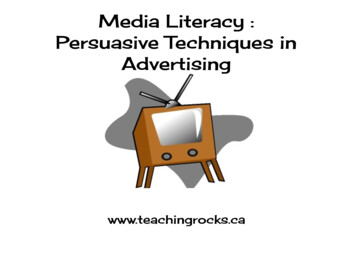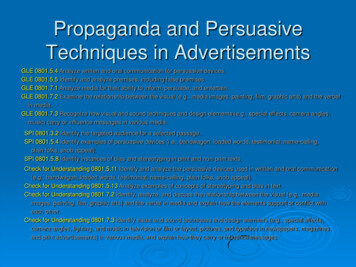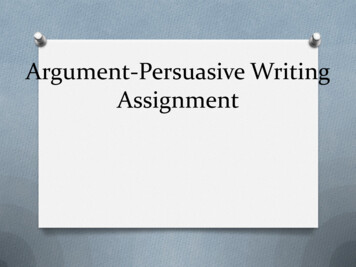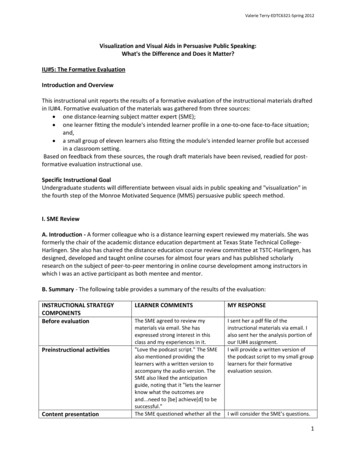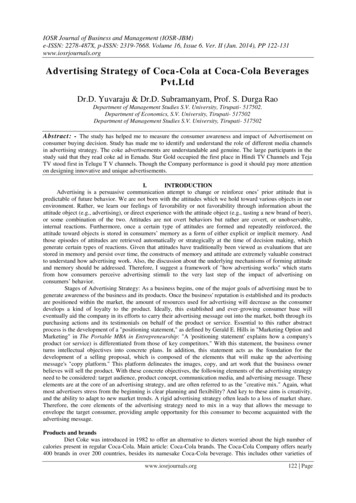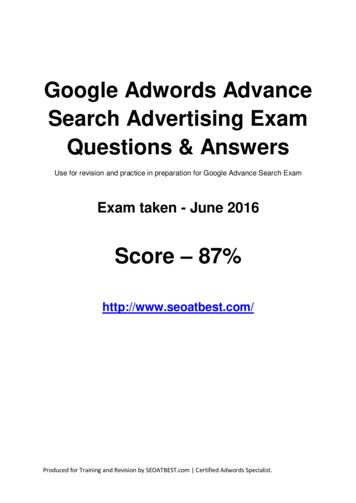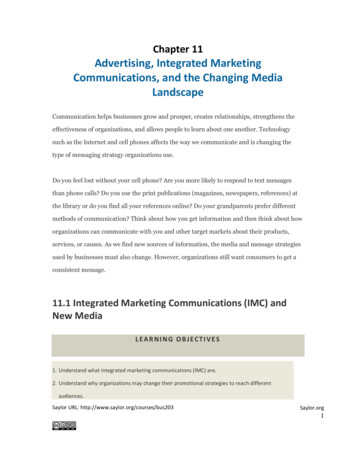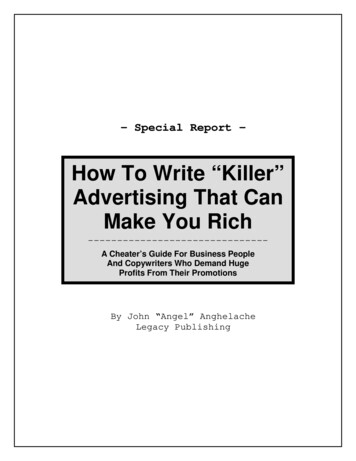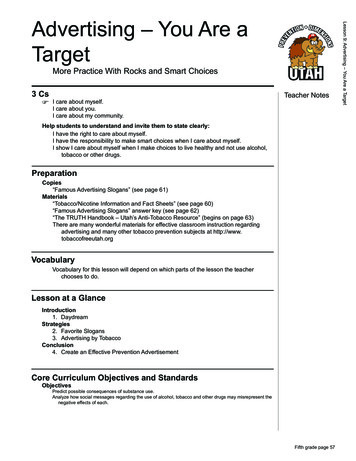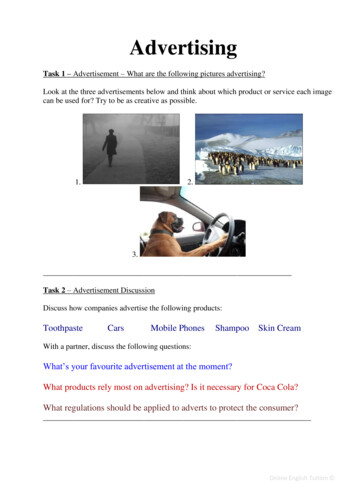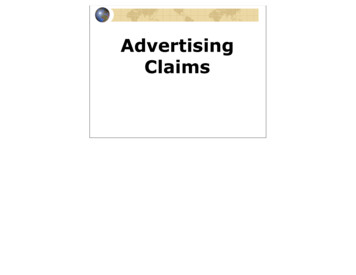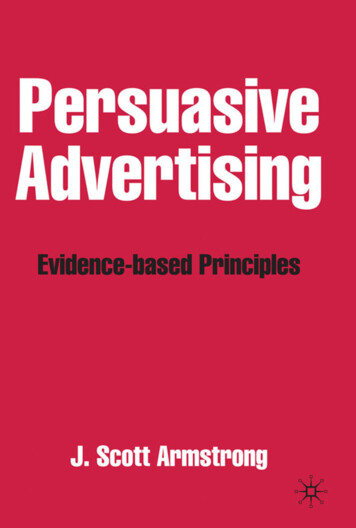
Transcription
10.1057/9780230285804 - Persuasive Advertising, J. Scott ArmstrongCopyright material from www.palgraveconnect.com - licensed to University of California, Los Angeles - Biol Chem - PalgraveConnect - 2011-04-14Persuasive Advertising
10.1057/9780230285804 - Persuasive Advertising, J. Scott ArmstrongCopyright material from www.palgraveconnect.com - licensed to University of California, Los Angeles - Biol Chem - PalgraveConnect - 2011-04-14This page intentionally left blank
Evidence-based principlesJ. Scott ArmstrongThe Wharton SchoolUniversity of Pennsylvaniawith collaboration fromGerry LukemanChairman Emeritus, Ipsos ASIandSandeep PatnaikResearch Director, Gallup & Robinson10.1057/9780230285804 - Persuasive Advertising, J. Scott ArmstrongCopyright material from www.palgraveconnect.com - licensed to University of California, Los Angeles - Biol Chem - PalgraveConnect - 2011-04-14PERSUASIVEADVERTISING
J. Scott Armstrong 2010No portion of this publication may be reproduced, copied or transmittedsave with written permission or in accordance with the provisions of theCopyright, Designs and Patents Act 1988, or under the terms of any licencepermitting limited copying issued by the Copyright Licensing Agency,Saffron House, 6-10 Kirby Street, London EC1N 8TS.Any person who does any unauthorized act in relation to this publicationmay be liable to criminal prosecution and civil claims for damages.The author has asserted his right to be identified as the author of this workin accordance with the Copyright, Designs and Patents Act 1988.First published 2010 byPALGRAVE MACMILLANPalgrave Macmillan in the UK is an imprint of Macmillan Publishers Limited,registered in England, company number 785998, of Houndmills, Basingstoke,Hampshire RG21 6XS.Palgrave Macmillan in the US is a division of St Martin’s Press LLC,175 Fifth Avenue, New York, NY 10010.Palgrave Macmillan is the global academic imprint of the above companiesand has companies and representatives throughout the world.Palgrave and Macmillan are registered trademarks in the United States,the United Kingdom, Europe and other countriesISBN 978-1-4039-1343-2This book is printed on paper suitable for recycling and made from fullymanaged and sustained forest sources. Logging, pulping and manufacturingprocesses are expected to conform to the environmental regulations of thecountry of origin.A catalogue record for this book is available from the British Library.A catalog record for this book is available from the Library of Congress.10 9 8 7 6 5 4 3 2 119 18 17 16 15 14 13 12 11 10Printed and bound in Great Britain byCPI Antony Rowe, Chippenham and Eastbourne10.1057/9780230285804 - Persuasive Advertising, J. Scott ArmstrongCopyright material from www.palgraveconnect.com - licensed to University of California, Los Angeles - Biol Chem - PalgraveConnect - 2011-04-14All rights reserved. No reproduction, copy or transmission of thispublication may be made without written permission.
10.1057/9780230285804 - Persuasive Advertising, J. Scott ArmstrongCopyright material from www.palgraveconnect.com - licensed to University of California, Los Angeles - Biol Chem - PalgraveConnect - 2011-04-14To my wife, Kay Anderson Armstrong.My shipmate, partner, and pal for nearly half a century so far.My work on this book was a test of her patience.For example, Persuasive Advertising traveled with uson all of our vacations over many years.Her career in social science research and her commonsense approachenabled her to make numerous improvements to this book.
10.1057/9780230285804 - Persuasive Advertising, J. Scott ArmstrongCopyright material from www.palgraveconnect.com - licensed to University of California, Los Angeles - Biol Chem - PalgraveConnect - 2011-04-14This page intentionally left blank
List of ypes of evidence6Conditions14The principlesStrategy1. Information2. Influence3. Emotion4. Mere exposureGeneral tactics5. Resistance6. Acceptance7. Message8. AttentionMedia-specific tactics9. Still media10. Motion y278Evaluating advertisements287Conclusions293AppendicesA Challenges to generalizing from experimental evidenceB Data on print ads from Which Ad Pulled Best (WAPB)C Non-experimental data on TV commercialsD Prospect theory and persuasionE Media allocation methodsF. How to select an advertising agencyG Management presentations: An evidence-based checklistH Written management reports: An evidence-based checklistIAdvertingprinciples.com 9780230285804 - Persuasive Advertising, J. Scott ArmstrongCopyright material from www.palgraveconnect.com - licensed to University of California, Los Angeles - Biol Chem - PalgraveConnect - 2011-04-14Contents
viiiGlossaryReferences319325Name indexSubject indexPersuasion Principles Map36137738810.1057/9780230285804 - Persuasive Advertising, J. Scott ArmstrongCopyright material from www.palgraveconnect.com - licensed to University of California, Los Angeles - Biol Chem - PalgraveConnect - 2011-04-14CONTENTS
A Types of evidenceB Key areas of conditionsC Categories of persuasion principlesPrinciples checklists:1 Information2 Influence3 Emotion4 Mere exposure5 Overcoming resistance6 Acceptance7 Message8 Attention9 Still media10 Motion mediaD Developing and nurturing creativity: a checklistE Persuasion principles map10.1057/9780230285804 - Persuasive Advertising, J. Scott pyright material from www.palgraveconnect.com - licensed to University of California, Los Angeles - Biol Chem - PalgraveConnect - 2011-04-14Exhibits
Advertising is fundamentally persuasion.Bill Bernbach, 1960Persuasive Advertising is a guide for all who create or evaluate advertisements—forpeople in advertising agencies and advertising research companies, for those whohire agencies, and for those in companies that do their own advertising. The basicproposition is that evidence-based advertising principles underlie persuasion.And experimentation is the bedrock of the knowledge about these principles.To date, much of what is known about advertising has been hidden in obscureacademic papers. The objective of this book is to put useful knowledge aboutpersuasion into an understandable and easy-to-access format. Therefore, I useeveryday language. For example, customers “think about a product” instead of“engage in cognitive processing of stimuli.”Many of the principles have profound effects, some of which are counterintuitive. At points in the book, you will have the opportunity to predict theoutcome of some of the studies underlying the principles. I hope you will findmuch evidence that contradicts your current beliefs. Such evidence will be usefulto readers who heed Winston Churchill’s warning, “Men occasionally stumbleover the truth, but most of them pick themselves up and hurry off as if nothinghad happened.”While typical practice and expert opinions are consistent with many of theprinciples, empirical evidence provides the most valuable support. This bookdraws upon thousands of research studies that reveal when the principles aremost effective and how to apply them.Understanding evidence-based principles can improve the ability of novicesand experts to develop persuasive advertising. It will help advertisers appreciatethe challenges that their advertising agencies face as well as contribute to goodlong-term relationships between sellers and buyers. As you will discover, somecommonly accepted practices that appear to be persuasive could be detrimentalin the long-term.Each year advertisers spend enormous sums to market their productsand services. Understanding and applying the Persuasive Advertising principleswill enable them to accomplish the job of marketing more effectively and ata lower cost.10.1057/9780230285804 - Persuasive Advertising, J. Scott ArmstrongCopyright material from www.palgraveconnect.com - licensed to University of California, Los Angeles - Biol Chem - PalgraveConnect - 2011-04-14Preface
Gerry Lukeman, Chairman Emeritus, Ipsos ASI took an interest in the bookstarting in November 2006. Over the next three years, he guided me towards theinterests of practitioners, provided access to unpublished findings from the filesat Ipsos ASI, and greatly improved the organization and clarity of the writing.He was merciless when I lapsed into academic bafflegab. He added examplesand provided access to people in the advertising field. His contributions hada profound influence on the book.Dr. Sandeep Patnaik, Research Director at Gallup & Robinson, took the lead inevaluating the principles by analyzing “quasi-experimental data” on tested printads. We were initially uncertain about the value of this project. As it turned out, thisoriginal research proved to be immensely valuable. There was a close correspondence between the results of the quasi-experimental and experimental analyses.The book also presents previously unpublished commercial research. DaveWalker, Senior Vice President, Global Research Director for Ipsos ASI, analyzeddata from tested TV commercials. He also helped in summarizing the findingsfrom these data.Although I never met him, I owe much to David Ogilvy. He translated hisknowledge into guidelines that were easy to use. In 1994, I started with Ogilvy’sguidelines and began the development of a decision-support system for advertising. This led to the conclusion that the guidelines needed to be refined so asto provide a more complete description of the actions that advertisers can take,as well as the conditions under which these actions apply. I refer to these asprinciples.I tried to trace the historical development of the persuasion principles. WhenI discuss historical facts prior to 1930, it is safe to assume that they came fromPresbrey (1929). Historical facts from 1930 onwards are from a variety of sources.In many cases, it was difficult to trace the stories to their origins. Many historicalfacts came from the Internet, often from a number of alternative sources, andthese are not cited specifically.Cynthia Cronin-Kardon, Jean Newland, and others at the Lippincott Library,University of Pennsylvania, tracked down papers no matter how obscurethe source or how incorrect the citation. This involved well over 2,600 papers,which were then entered into a data-base, a task that relied on many, and inparticular, Amelia Aldao, Michael Guth, Ankita Sancheti, Alexandra Yordanova,and Rachel Zibelman.It was difficult to find research assistants who could understand academicpapers enough to be able to summarize them in plain language. However, twowere especially good at this: Lisa Negron and Zhen Chai.Many academicians, including Andrew Abela, Willem Burgers, Peter Fader,Magne Jørgensen, Americus Reed III, Jenni Romaniuk, Brian Martin, ByronSharp, and Brian Wansink provided useful suggestions on the content.10.1057/9780230285804 - Persuasive Advertising, J. Scott ArmstrongCopyright material from www.palgraveconnect.com - licensed to University of California, Los Angeles - Biol Chem - PalgraveConnect - 2011-04-14Acknowledgments
ACKNOWLEDGMENTSJohn A. Carstens spent more than four years with the writing, design, organization, and word processing, thus putting his years of teaching college compositionand editing faculty papers to good use. He was also good at determining what Imeant to say, which was sometimes different from what I said. He died in May2006 and I miss him.I drew upon knowledge from many fields. To ensure that this knowledge hasbeen properly transmitted into principles, I, along with Amelia Aldao, AprilAnderson, Saurabh Bajpai, Michael Guth, Jim Liu, Rachel Zibelman, and Alexandra Yordanova, tried to contact all living researchers whose work is cited. Mydeepest appreciation to those people who came back with detailed suggestionsfor improvements. Shane Frederick, Richard P. Larrick, Daniel O’Keefe, and RikPieters were especially helpful in this effort.In a further attempt to improve the accuracy and usefulness of the summaries of research, I asked various researchers to review some contentious sections.Reviews were provided by Charles Areni on “Questions,” Pierre Chandonon “Product information,” Jean-Charles Chebat on “Two-sided arguments”and “Indirect versus direct conclusions,” Phil Gendall and Robert Schindleron “Pricing,” Sheena Iyengar, Cassie Mogilner, and Benjamin Scheibehenneon “Product choices,” Ekant Veer on “Cause-related marketing,” Patti Williamson “Mere exposure,” and Eric S. Knowles on “Resistance.”My commissioning editor at Palgrave Macmillan, Stephen Rutt, read early draftsand provided suggestions on how to make the book useful to practitioners.Many people helped with editing as the manuscript progressed through morethan 270 revisions. April Anderson, Stuart Halpern, Bryan La France, Soo Lee,and Jen Zhao went through the whole book and provided wonderfulsuggestions.Others helped to improve clarity by commenting on sections of the book.A partial list includes Zain Akbari, Adam Altman, Jennifer Armstrong, DessaCrawford, Ishika Das, Sarah Fastabend, Max Feldman, Deborah Fox, Lela Jacobson,Julie Johnson, Kelly Xiayu Jin, Allen Jun, Cindy Kim, Marian Lee, Elena Liao,Diana Lin, Douglas Martin, Mariam Rafi, Eleanor Segal, Andrew Snyder, SharaVanetia-Walerstein, Alex Wilson, Dara Yang, and Jennifer Yoo.As we neared the final draft, Alice Barrett Mack went though the book and dida superb job of editing. Susan Curran did a great job on editing and design.I received guidance from advertisers, including Tony Adams, a consultant andformerly an advertising executive at the Campbell Soup Company; W. WarrenArmstrong of Armstrong Marketing Services; and Ralph Day, a consultant.Charles Smolover, a creative director at the Mangos advertising agency inMalvern, Pennsylvania, encouraged me to read the classics in advertising earlyon in this venture. He also pr
Persuasive Advertising is a guide for all who create or evaluate advertisements—for people in advertising agencies and advertising research companies, for those who hire agencies, and for those in companies that do their own advertising. The basic proposition is that evidence-based advertising principles underlie persuasion. And experimentation is the bedrock of the knowledge about these .
